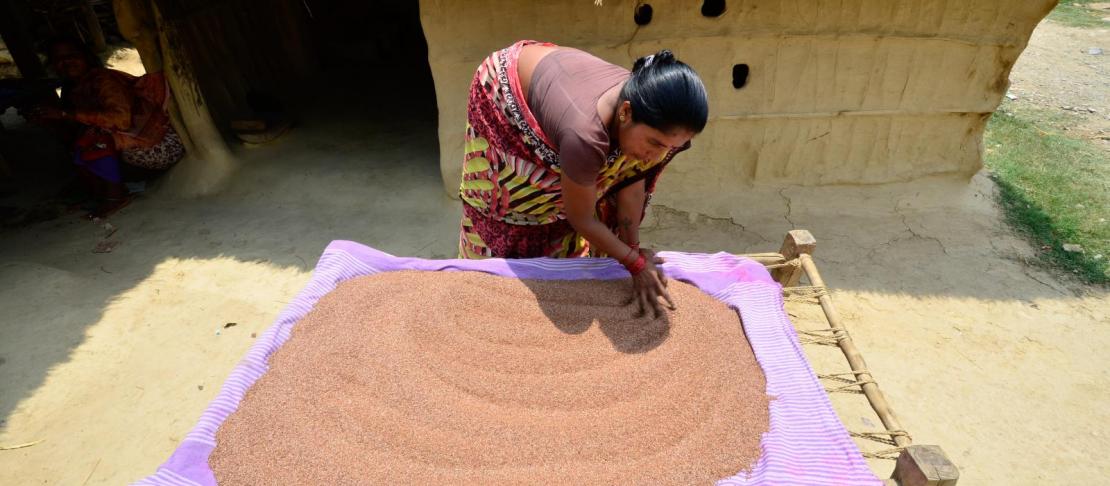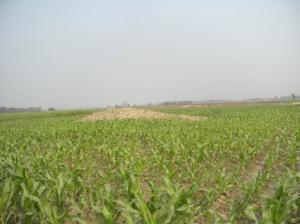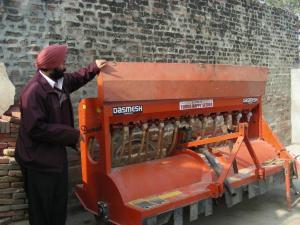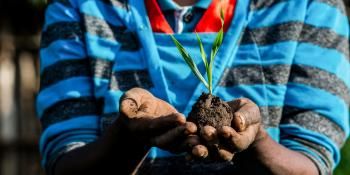Reframing climate adaptive agricultural innovation

by Rasheed Sulaiman
Indian agriculture is extremely sensitive to climate change and its impact is increasing over time1. The Indo-Gangetic Plains (IGPs) in India, which is considered as its “bread basket” providing food security and employment to several hundred millions of people, is extremely vulnerable to climate risks2,3. Adaptation to the adverse effects of climate change is therefore vital for securing agricultural growth and poverty reduction for this region.
Adaptation is not a new phenomenon per se in agriculture as agricultural systems have always been responding to improved technologies, better market opportunities and changing weather patterns. However, the nature and speed of adaptation vary considerably in different regions and among varied social groups. Understanding this process of local adaptation or innovation is extremely important for the successful design of policies, programmes and interventions that address climate risks.
Our research on understanding how communities learn to adapt to climate risks and how different actors in the Agricultural Innovation System (AIS) influence this adaptation has led to new insights on climate adaptive agricultural innovation. In India the study focused on 3 sites in the IGP, namely Sangrur (Punjab); Madhepura and Nalanda (both in Bihar); and in one non-IGP site, Udaipur (Rajasthan).
Every farmer, rural household and community with whom we interacted has been, one way or the other, adversely affected by climate risks in their farming. These risks include: increase in temperature, decrease in rainy days, increase in precipitation on rainy days, shorter winter period, decreased ground water availability, increased occurrence of drought and floods, increased duration of water logging etc. All these have resulted in loss of season for growing the crop or partial or full yield loss.
Farmers, often with the support of other actors have been trying to adapt to these climate risks in different ways. Most of these adaptations are technological often pushed or promoted by research and extension agencies involved in agriculture. For instance, changing the date of planting (to reduce the depletion of subsoil water), promoting new paddy varieties that can better tolerate water-logging (Swarna Sub 1) are of short duration (PAU 201 and Rajendra Mansuri), promoting new machinery (zero drills, rotavator, laser leveler and happy seeder), introducing new crops that can increase fertility (summer moong and gram as an intercrop in wheat) and diversification to vegetables and fisheries, promoting SRI (systems of Rice Intensification) in paddy are some of the technological innovation promoted in the region.
Only few initiatives have focused on enhancing capacities of producers to deal with changing climate and ensuring long term resilience. These have come from broad rural development initiatives of “Jeevika” (Bihar Rural Livelihoods Project) in Bihar or efforts of NGOs such as Sahyog Sanstan and Seva Mandir in Rajasthan. All these initiatives initially focused on mobilizing poor communities through village organizations (self help groups) to primarily reducing rural poverty (Jeevika in Bihar) or improving their capacities for managing natural resources (pasture lands in Udaipur).

Many of their interventions involved application of new technologies and practices in agriculture and these are proving to be more effective in addressing climate risks. For instance Jeevika has been promoting SRI very effectively through the social infrastructure it created (SHGs, Village Organisations and Village Resource Persons) and SRI has helped the poor to adapt better to drought by way of reduced input use and higher productivity. Similarly the communities who have been part of community managed pasture lands in Udaipur have been able to maintain adequate supply of fodder for their cattle during extreme drought conditions.
While the above institutional innovations promoted through community mobilization and creation of knowledge networks are helping farmers to better adapt to climate risks, the technological innovations promoted by way of conventional transfer of technology approaches have limited impact so far. Most of the technical innovations haven’t had much impact due to lack of complementary support needed for their widespread use.
Diversification towards vegetables and fisheries that can better tolerate climate risks in North Bihar hasn’t succeeded due to lack of facilities for marketing. However more farmers are shifting to maize cultivation in Bihar mainly due to the high price for maize and its better tolerance to climate risks. Lack of community mobilization for addressing problems in agriculture has also constrained farmers in Punjab and North Bihar from responding effectively to new threats and opportunities resulting from climate risks.

Adaptation to climate change is currently perceived in India as farm level technological adaptation and there is little appreciation to the fact that organizations also have to adapt institutions and policies to better respond to climatic risks. “Climate change adaptation requires coherent technical and institutional innovations and response across multiple societal levels”4. It is mainly the lack of institutional innovations (new rules, guidelines, behavior, or ways of working) that is constraining actors engaged in research, extension and training from supporting farmers to better adapt to climate risks.
Promoting technological innovations through demonstrations and training, without addressing the complimentary support and services required for putting this technical knowledge into use5 is not leading to wider impact. Current efforts are too “grass root” focused thus ignoring required changes within organizations to support adaptation. While new capacities have to be built among all the actors in the AIS, capacity is often perceived as training farmers and distributing inputs and implements/machinery.
If farmers in the IGPs have to adapt better to increasing climate risks, there is a need to reframe our approach to adaptation beyond promotion of technical innovations. A coherent approach combining technical and institutional innovations at different levels is needed to address climate change issues in agriculture. Farmers have to adapt and they will do it better, if they are supported in this process through technological, institutional and policy changes. But to support farmers, much adaptation has to happen within the organizations that are meant to be supporting the farmers.
Some of the practical steps include:
- Diagnosis of the Agricultural Innovation System (AIS) specifically looking for institutional and policy changes that are required within the organizations and their relationships and interactions
- Encourage research to partner with others who are involved in promoting adaptation and also support them technically to fine tune their adaptation strategies.
- Broadening the role of extension from technology dissemination to include community mobilization, facilitation, brokering and network development and organize human resources and funding to perform these roles
- Approach adaptation as a set of innovations in technical, institutional and policy related aspects not only at the farm level but among all the actors in the AIS.
References
- Ninan, K.N and Bedamatta, S 2012. Climate change, Agriculture, Poverty and Livelihoods: A status Report, Working Paper, 277, Institute of Social and Economic Change, Bangalore http://www.isec.ac.in/WP%20277_K%20N%20Ninan.pdf
- Aggarwal, P.K, Joshi,P.K, Ingram, J.S.I and Gupta, R.K. 2004. Adapting food systems of the Indo-Gangetic plains to global environmental change: key information needs to improve policy formulation, Environmental Science and Policy Vol 7 (2004) pp 487–498
- Jodha, N.S. 2011 Climate change and adaptation Strategies in Indo-Gangetic Plains of India, International Centre for Integrated Mountain Development, Kathmandu, Nepal
- Leuwis, C and Hall, A. 2010 Facing the challenges of climate change and food security: The role of research, extension and communication institutions, FAO, 2010
- Sulaiman, R.V, Hall, A. Vamsidhar Reddy, T.S. and Kumuda Dorai 2010 Studying Rural Innovation Management: A Framework and Early Findings from RIU in South Asia. RIU Discussion Paper Series #2010-11, December 2010, Research Into Use (RIU): UK
More information
Read more about Climate Change, Agriculture and Food Security work in South Asia.
This blog post was written by Rasheed Sulaiman V, from the Centre for Research on Innovation and Science Policy (CRISP), Hyderabad, India. To get more updates on our research in South Asia follow us on Facebook and Twitter @Cgiarclimate.


